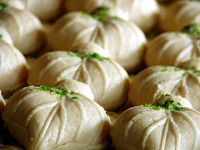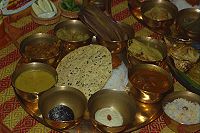- Sandesh (confectionery)
-
This article is about the Bengali Sweetmeat. For Sandesh, see Sandesh.
Sandesh 
Nollen Sandesh from West Bengal, IndiaOrigin Place of origin India Region or state Bengal Dish details Course served Dessert Main ingredient(s) Jaggery (Gurr), Condensed Milk Sandesh (Bengali: সন্দেশ Shôndesh, Hindi: संदेश) is a sweet snack originated and still very popular in Bengal region (present independent Bangladesh and West Bengal, a province of India ). It is created with milk and sugar [1]. Some recipes of Sandesh call for the use of chhana (curdled milk) or paneer instead of milk [2]. Some people in the region of Dhaka call it pranahara (literally, heart 'stealer') which is a softer kind of sandesh, made with mawa and the essence of curd [3]. Sandesh is also mentioned in the Bollywood film 'Devdas' (2002) where both Hindustani and Bengali cultures were portrayed. The best sandesh makers are from Narail and Dhaka in Bangladesh and Kolkata in West Bengal, India. Parijat, Rose Cream, Dilkhush, Abar Khabo, Chocolate Talsansh are among the most popular types. Nakur, Bhim Nag, Makhon and Nalin Sarkar are some of the shops in Kolkata. "Makha" sandesh hails from Bardhaman district.
Another popular Bengali sweet snack Ras malai is also a modified version of Sandesh. While Sandesh is dry, Ras malai is soaked in clotted cream. Ras malai from Comilla Bangladesh is the most popular of its kind.
Preparation
The most common way of making the sandesh is with the use of Chhana or cottage cheese. Chhana is the solid form which is separated by curdling milk, and it has wide application in sweet-preparation in Bengal. The simplest kind of Sandesh in Bengal is the kanchagolla. It is basically prepared by tossing the Chhana lightly with sugar over low heat. The sandesh is essentially hot, sweetened Chhana which has been shaped into balls. For the more complex and elaborately prepared sandesh, the chhana which is used for preparation is dried and pressed, flavoured with essence of fruits, sometimes even coloured and cooked to many different levels of consistencies. Sometimes it is filled with syrup, blended with coconut or kheer and moulded into a variety of shapes. These shapes can frequently be seen resembling conch-shells, elephants, fish etc. The shapes are mostly given my way of moulds. The majority of these moulds are carved out of stone, though some may also be carved from wood.
References
External links
Categories:- Bengali cuisine
- Indian desserts
- Dessert stubs
- Indian cuisine stubs
Wikimedia Foundation. 2010.

